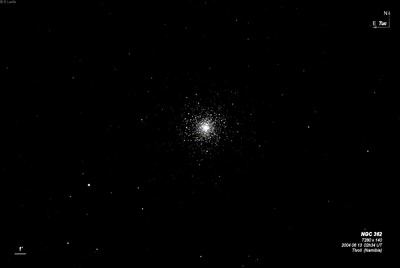
James Dunlop discovered NGC 362 = D 62 on 1 Aug 1826 with a 9" speculum reflector and described "a beautiful bright round nebula, about 4' diameter, exceedingly condensed. This is a good representation of the 2nd of the Connaissance des Temps [M2] in figure, colour, and distance; it is but a very little easier resolved, rather a brighter white, and perhaps more compact and globular. This is a beautiful globe of white light; resolvable; the stars are very little scattered." He observed the globular 11 times (sketched in Figure 3 of his catalogue) and his published position is just 2' NE of center.
John Herschel (h2375) reported it with his 18" reflector from the Cape of Good Hope on 12 Aug 1834 as a "Fine, highly condensed globular cluster; psbM; diameter 4'." On 3 Nov 1834 he called it "vB; vL; psvmbM; round; 5' or 6' diameter; all resolved." Observing the next night, he recorded it as "a globular cluster; vB; vlE; gvmbM. Diameter of more condensed part approx. 60 sec in RA; but there are loose stars to a considerably greater distance, stars 13 or 14 mag all nearly equal and distinct, but run into a blaze in centre." His final observation reads: "globular cluster, vB, very compact; psvmb; 4' across; all resolved into stars 13..15 magnitude."
There was a 1.0 tmin error in reduction in the NGC position too far west (Dreyer, IC 2 notes). This error was noted in Harvard College Observatory NGC corrections.
400/500mm - 18" (7/6/02 - Magellan Observatory, Australia): At 228x, NGC 362 appeared very bright and well-resolved into a couple of hundred stars! The rich halo was plastered with stars and extended to nearly 8’ diameter. The 2' compressed core was well-concentrated to a blazing center (concentration class III). Stars appeared to stream out of the core in curving spiral lanes. This globular had a classic symmetric appearance with a prominent, round core and halo. NGC 362 is situated just north of the SMC, though 47 Tuc (NGC 104) overshadows the splendor of NGC 362.
Naked-eye - (11/4/12 - Coromandel Peninsula, New Zealand): this 6.6-magnitude globular was just visible naked-eye to the north of the SMC.
Notes by Steve Gottlieb